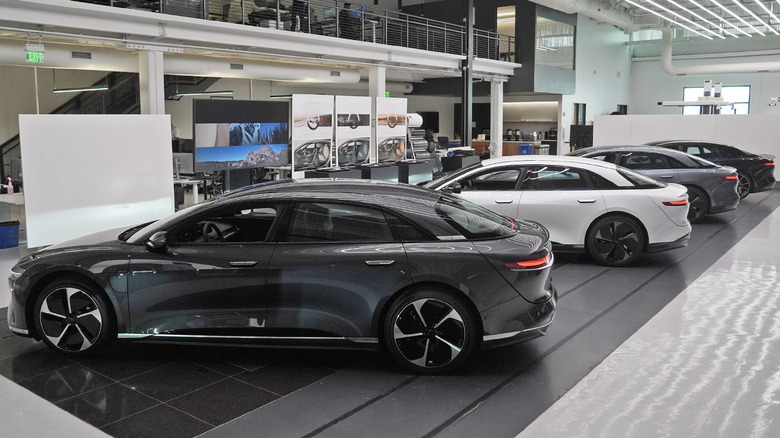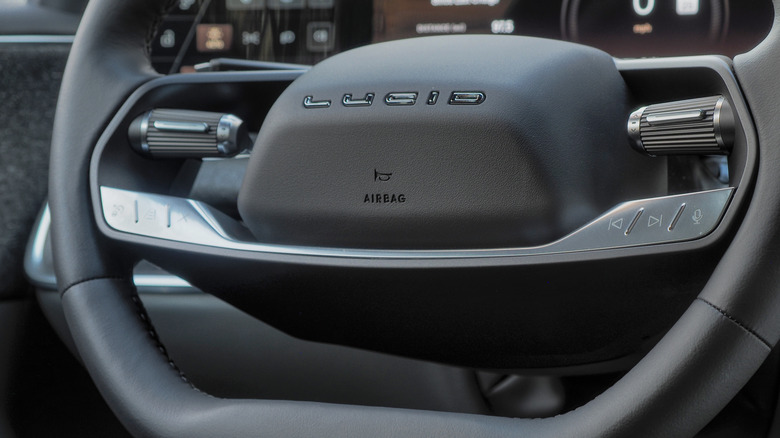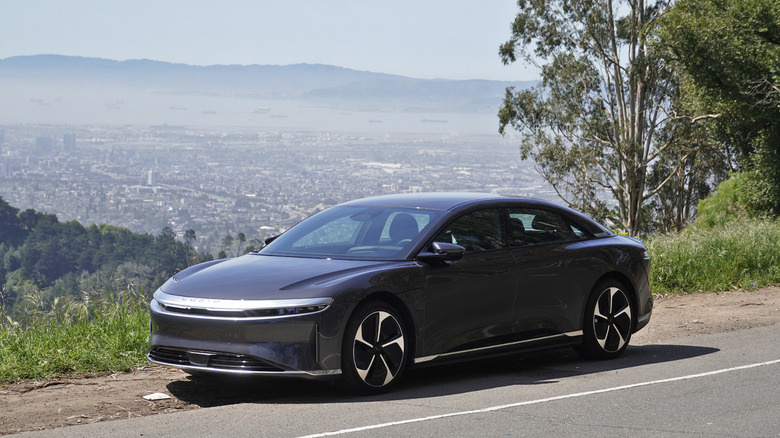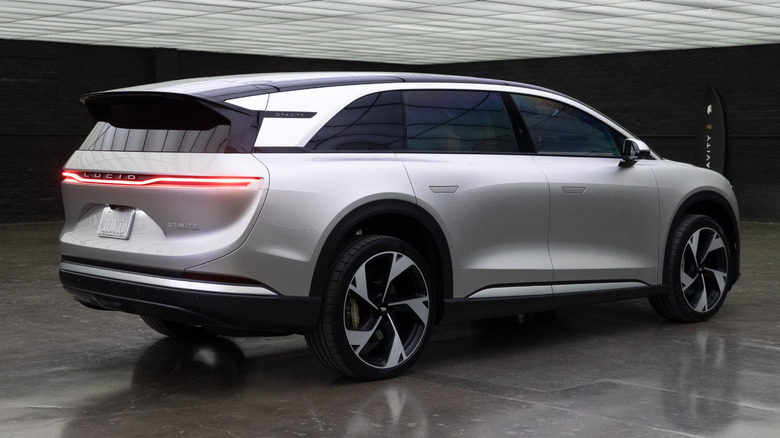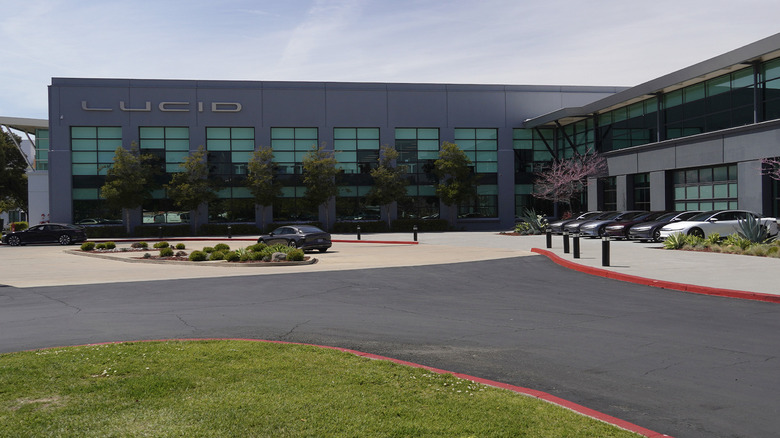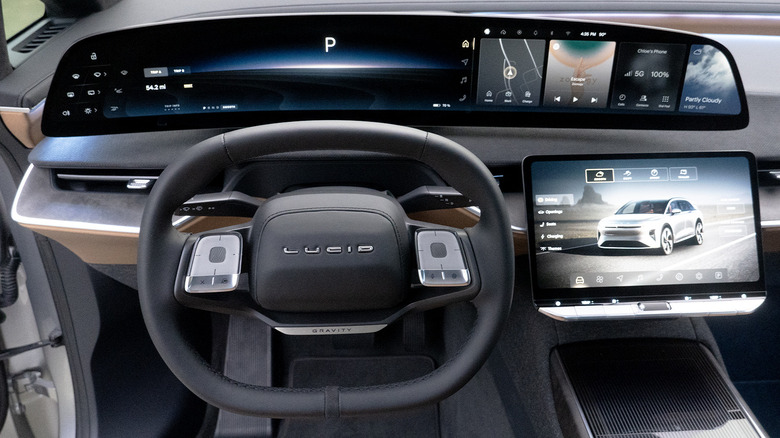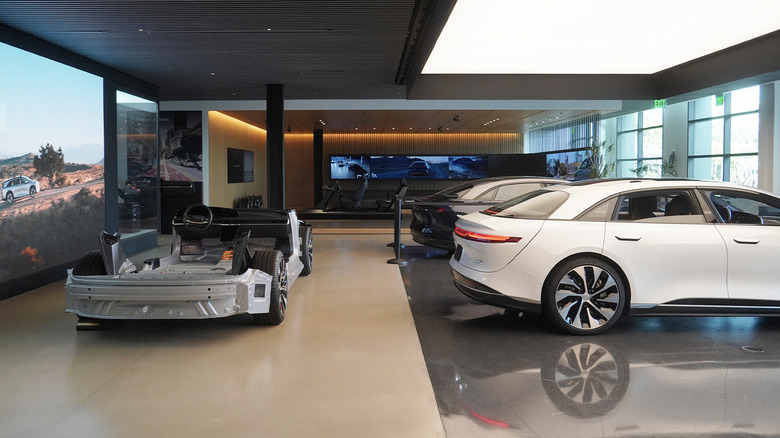Lucid Just Previewed The Two New EVs Its Survival Depends On: Here's What We Saw
Lucid clearly knows how to build a fast electric car: In 2024 and beyond, the challenge is selling more of them as it readies an assault on the EV mainstream. To start, the Air lineup is expanding up and downmarket simultaneously, despite dropping the Air Grand Touring Performance trim level. Instead, the tri-motor Sapphire now rules over the roost with 1,234 horsepower and 427 miles of range, at a starting price of $249,000. Meanwhile, the Grand Touring now slots in as probably the most impressive Lucid for the money, starting at $109,900 and offering up to 516 miles of EPA-estimated electric range. The GT also borrows a heat pump from the Sapphire to improve cold-weather performance.
Subtle updates to the entire lineup include a new automatic pre-conditioning program to speed up charge times. But, most importantly, 2024 marks the model year debut of the most important Air to date, the base Pure RWD. As the most attainable Lucid on the market, the Pure RWD starts at $69,900 and still manages 419 miles of EPA range and 420 horsepower from a single electric motor.
Record-breaking efficiency isn't enough to secure Lucid's future
With an 88-kWh battery, that 4.74-kWh per mile makes the Pure RWD the most efficient EV on the market today. In fact, Lucid's full spread of about $180,000 across the gradewalk for a single model might represent some kind of automotive record, and even if the Pure RWD can't quite match the ungodly acceleration of the top-spec Sapphire—which somehow can easily log a 0-60 time of 1.89 seconds despite being on production tires—the base car makes few sacrifices in terms of real-world performance and luxury.
Last week, Lucid Motors hosted select media at the company's headquarters in Newark, California, not far from the San Francisco Bay's eastern shore. The event included seat time in the full 2024 gradewalk of the Air sedan, as well as updates on overall business strategy and sneak peeks at forthcoming models that need to help bolster sales volume.
Developing new models to support sales targets
Part of the Pure RWD's impressive capability is because the same team actually worked on developing it and the Sapphire simultaneously, due to the more pressing traction and steering challenges for both the most powerful Air and the first rear-wheel-drive version. While the Sapphire required Lucid to develop in-house traction and stability control software that processes much faster than the former Tier 1 supplier system used on previous Airs, harnessing the Pure RWD's power via only two tires presented a similar conundrum. Especially as the R&D team worked out revisions to the front-end steering and suspension dynamics to help iron out any differences versus the previous all-wheel-drive Airs.
As much as the Sapphire might make headlines as the second-quickest accelerating production vehicle of all time—behind the Rimac Nevera which will cost you approximately 10 times as much—the Pure RWD's success will undoubtedly mean more to Lucid from a business perspective.
Lucid's second model is still a work-in-progress
At HQ, Lucid Chief Executive Officer and Chief Technology Officer Peter Rawlinson stopped by to discuss plans for continued growth at the AMP-1 plant in Casa Grande, Arizona, where he predicted that updates and expansion to the facility will allow for the production of 90,000 vehicles per year starting in 2025.
But this year, Lucid only plans to sell 9,000 units, after a record first quarter that included the production of 1,728 Airs (down 27% from Q4 2023) and a sales total of 1,967 (up 13%). That leaves 7,300 more vehicles to be built over the next nine months, which Rawlinson hopes will be bolstered by the price drops for model year 2024. Without a doubt, to reach the kind of volume targets that Rawlinson and Lucid have set, forthcoming models need to help with both sales and recognition.
The previously announced Gravity, a full-sized SUV that will seat up to eight passengers, continues development and testing. Two test mules in the Newark facility showed the wear of road miles on camouflaged patterned wrap jobs, as engineers hope to dial in driving dynamics and the potentially world-beating 0.24 coefficient of drag (a record for full-sized SUVs if real life holds up to CFD modeling).
Teasing future mid-size platform concepts
In Lucid's design studio, meanwhile, Senior Vice President of Design and Brand Derek Jenkins showed off a Gravity without the camouflage, instead finished in a new Aurora Green paint tone that helps to accentuate the SUV's more flattering angles. Gravity will also come in two other new colors, Lunar Titanium and Supernova Bronze, in addition to shades already available on the Air.
New tech updates include the so-called "Digital Detox" which reduces the large dual screens' readouts to minimize light and distraction. Jenkins noted few changes from the Gravity show car that debuted before last year's Los Angeles International Auto Show, before walking those in attendance over to the area of the studio where the show cars are actually built.
Here, any photography got the kibosh as Rawlinson and Jenkins teased two mockups of forthcoming models they currently refer to simply as based on an all-new "mid-size" platform. Hidden under form-fitting sheets, the rakish proportions of both stood in contrast to the known quantities of the Air and Gravity.
Attainability rather than record-setting range is the goal
Visible near the ground, low-profile performance tires on the smaller model hinted at potentially a more crossover-inspired use case, while Toyo Open Country A/T III knobbies on the second design combined with the rails of a roof rack to hint at a true mid-size SUV's off-roading purpose.
Taking a closer look revealed further differences in the overall shapes, too. The CUV seemed to bulge more over the front hood, with more aggressive intake strakes and more definition to the muscular haunches. Overall, the proportions approached the sportback roofline similar to a Range Rover Velar. The SUV looked a little more chunky or boxy, with a solid ride height and fewer stylistic enhancements.
When Jenkins lifted a corner of the sheet for just a bit more of a tease, a vertical air vent behind the CUV's right rear tire certainly harkened to the Air's design language. Next to the two draped shapes, Rawlinson discussed that Lucid hopes each will start at a target price in the $48,000 to $50,000 range. He said the goal will be less about beating the competition in range terms, as the Air has handily, but more about meeting similar range numbers while excelling in performance and quality terms.
Goals for Lucid's future lineup
Such low pricing and the general popularity of crossovers and SUVs in America should contribute to further volume increases, if Q1's record for the Air after the 2024 price drops suggests anything. And if past performance indicates future success, hopefully the full-size Gravity and the two mid-size concepts can continue to deliver the borderline unbelievable combination of luxury and sporty performance that Lucid managed to nail with the Air.
Many of the journalists on hand arrived at Lucid immediately after or before a trip with Hyundai to test drive the Ioniq 5 N at WeatherTech Raceway Laguna Seca. There, quite possibly the most exciting new EV on the market proved that enhancing a consumer crossover can deliver new levels of peppy, snorty, rip-roaring fun. A new benchmark set, no doubt, but the I5 N starts at $66,100 with a disappointing EPA range estimate of just 221 miles.
Given the impressive development of the Sapphire and Pure RWD trims—in terms of power output, handling, and compact motor and battery technology—the chances seem good that either of Lucid's mid-size models will manage to match the same level of driver engagement, all in a more luxurious and efficiently packaged vehicle of a similar size. The mid-size platform will enter the market, likely not before 2026, positioned to attract a wider swath of the EV-buying public's attention. After ramping up from production of a full-size sedan, arguably the least popular segment in the automotive industry today, hopefully transitioning to broader appeal will help Lucid to more quickly achieve the recognition required to keep the business outlook strong.
